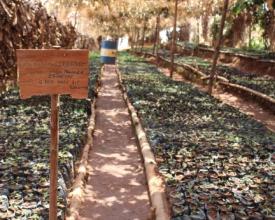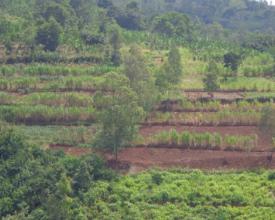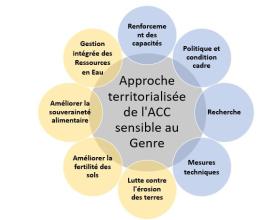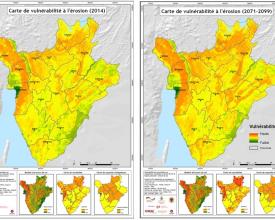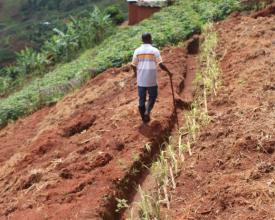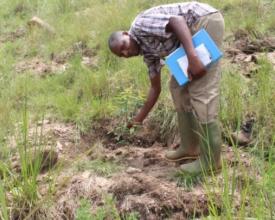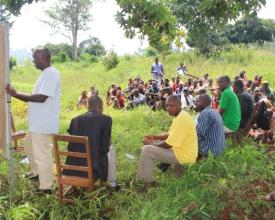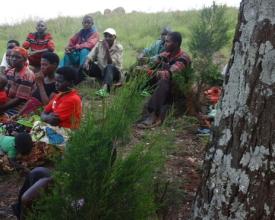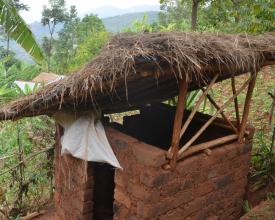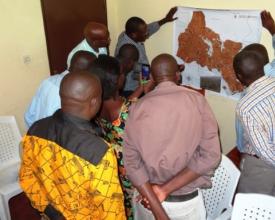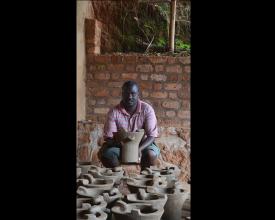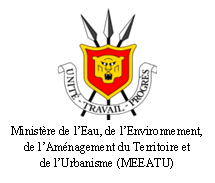
Gestión resistente de los recursos hídricos y edáficos en Burundi
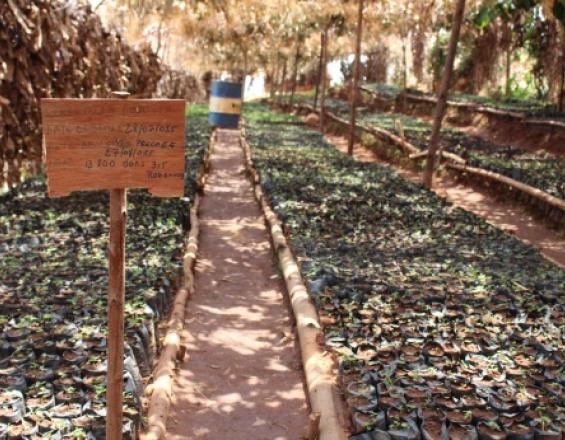
El proyecto ACCES de la GIZ aplica medidas de adaptación en cuencas vulnerables. Los recursos naturales, como el agua y el suelo, se gestionan de forma sostenible para reducir la erosión y mejorar los rendimientos agrícolas. Las medidas de adaptación "verdes" sin arrepentimiento, como la agrosilvicultura y la reforestación comunitaria, se complementan con otras medidas como el almacenamiento de agua de lluvia y el fomento de la infiltración del agua de lluvia y las medidas de conservación del suelo.
Contexto
Défis à relever
La población de Burundi, muy dependiente de la agricultura y los recursos naturales, está sumida en la pobreza y sufre escasez de alimentos y hambrunas recurrentes. La degradación de los ecosistemas y de los recursos hídricos y edáficos se debe, entre otras cosas, a la fuerte presión sobre los recursos de la tierra, la explotación inadecuada de los recursos naturales y la sobreexplotación de los recursos forestales. Estos problemas se ven agravados por el cambio climático:
- Aumento de las precipitaciones en las regiones oriental y meridional del país y en la meseta central.
- Meses más secos antes de la temporada de lluvias
- Posible prolongación de la estación seca
- Alta probabilidad de un aumento medio anual de las temperaturas del aire durante el siglo XXI, especialmente durante la estación seca
- Mayor riesgo de fenómenos extremos (inundaciones, corrimientos de tierras, etc.).
Ubicación
Procesar
Resumen del proceso
Los componentes básicos interactúan según un enfoque holístico basado en la aplicación de actividades/medidas de ACC sin arrepentimiento derivadas de un análisis "de abajo arriba" y "de arriba abajo". Estas medidas son fiables y fácilmente reproducibles porque se adaptan al contexto local y se comparten con la población. El siguiente diagrama representa el enfoque territorializado y sensible al género de la ACC del proyecto, que se basa en varios pilares (diseño holístico): Gestión Integrada de los Recursos Hídricos (GIRH), mejora de la fertilidad del suelo, soberanía alimentaria y lucha contra la erosión del suelo. Para lograrlo, el proyecto utiliza varios tipos de medidas de ACC: desarrollo de capacidades, intervenciones sobre políticas y condiciones marco, medidas técnicas ecológicas e investigación-acción.
Bloques de construcción
Análisis integrado de la vulnerabilidad a escala nacional y local
La evaluación de la vulnerabilidad se llevó a cabo para tres períodos: el statu quo en 2014, el período 2030-2060 y el período 2070-2100. La evaluación sigue el enfoque de ocho pasos descrito en el Vulnerability Sourcebook de la GIZ, y se complementó con una modelización científica de los impactos del cambio climático para Burundi.
El estudio fue realizado por tres instituciones (Adelphi, EURAC, PIK) en colaboración con GIZ / ACCES y sus socios. Se celebraron cuatro talleres nacionales con todas las partes interesadas. Se creó un grupo de expertos para asesorar y dirigir el proceso. Las actividades a nivel local en los lugares seleccionados para el proyecto se llevaron a cabo en estrecha colaboración con los agentes gubernamentales y no gubernamentales locales y la población local.
Los resultados de la evaluación se presentaron en forma de mapas de vulnerabilidad para los tres factores de erosión, sequía y prevalencia de la malaria. Se han identificado zonas altamente vulnerables para orientar la identificación de tres cuencas piloto. En estas cuencas se llevaron a cabo evaluaciones de la vulnerabilidad local para identificar los retos locales y las medidas de adaptación adecuadas.
Factores facilitadores
- Talleres nacionales: permitieron a los participantes (gobierno y sociedad civil) comprender mejor el proceso y compartir sus perspectivas y conocimientos sobre el tema.
- Creación de un grupo de expertos compuesto por expertos de varios ministerios e instituciones de Burundi: importante para la apropiación del propio proceso y sus resultados.
- Integración de la evaluación de la vulnerabilidad en el proceso del Plan Nacional de Adaptación (PNA) de Burundi.
Lección aprendida
- La disponibilidad de datos fue un reto importante. La mayoría de los registros gubernamentales no están clasificados y los documentos y la información son incompletos. A menudo, los datos agregados sólo están disponibles a nivel nacional y provincial, lo que dificulta la comunicación a nivel local.
- Los resultados de la evaluación de la vulnerabilidad constituyen la base para integrar la adaptación al cambio climático en las políticas, estrategias y planes de inversión nacionales y locales. Otros agentes pueden utilizar esta experiencia e información para la planificación de la adaptación.
- La metodología utilizada para evaluar la vulnerabilidad en Burundi se basa en una metodología normalizada, lo que permite su reproducción.
Recursos
Enfoque holístico y participativo de la adaptación al cambio climático
El proyecto ACCES desarrolló un enfoque holístico y participativo mediante la aplicación de medidas de adaptación en las 3 zonas piloto. Este enfoque tiene en cuenta las dimensiones medioambiental, social, económica y pedoclimática de Burundi.
Las sucesivas etapas de aplicación han consistido en establecer una lista de medidas de adaptación que puedan responder a los estímulos climáticos. Estas medidas se han clasificado según su tipología: medidas grises, medidas verdes, desarrollo de capacidades, investigación-acción, marco político. El proyecto dio prioridad a las medidas de desarrollo de capacidades y a las medidas verdes por cuestiones de viabilidad y sostenibilidad. A continuación, el proyecto organizó talleres de planificación participativa en cada una de las zonas piloto para evaluar su aceptabilidad en consulta con la población. El resultado fue un conjunto de medidas de ACC consensuadas y específicas para cada una de las zonas. Para garantizar la calidad y la sostenibilidad, se creó localmente un comité técnico de seguimiento (CTS-L). Este comité está formado por personas de la administración local, líderes agrícolas y dirigentes de asociaciones, que se encargan del seguimiento y la sostenibilidad de las medidas.
Factores facilitadores
- Refuerzo de las capacidades de los agentes a todos los niveles en materia de CC y ACC
- Buen conocimiento de las prácticas agrícolas de las zonas de intervención (estrecha colaboración con INADES-Formación Burundi)
- Planificación participativa de las medidas de ACC con la población local para garantizar una buena aceptabilidad
- Creación y formación de un Comité Técnico Local de Seguimiento, grupo representativo de los intereses de la población para garantizar la calidad y sostenibilidad de las medidas de ACC.
Lección aprendida
Para garantizar la sostenibilidad de las medidas de ACC, es imperativo asegurar el apoyo público (a través de la planificación participativa), la comprensión (formación, sensibilización, desarrollo de capacidades) y la rendición de cuentas (comité técnico).
El enfoque holístico de las medidas de adaptación se ha basado en un planteamiento transversal de las cuestiones medioambientales en Burundi, aprovechando también la experiencia de otros proyectos de la GIZ (Programas ProSecEau y EnDev).
Las medidas innovadoras se probaron primero a pequeña escala para evaluar su impacto. Una vez validadas, estas medidas podían reproducirse en las demás áreas de intervención del proyecto.
Adaptación, género y capacitación de las mujeres: un enfoque integrado
En Burundi, las desigualdades de género siguen limitando el acceso de las mujeres a la toma de decisiones, los recursos y los beneficios (educación, información, propiedad de la tierra, tiempo, empleos, créditos, etc.) y el reparto equitativo de las tareas. Ante esta situación, las mujeres son cada vez más vulnerables, pero también están excluidas de los esfuerzos de mitigación y adaptación a los efectos del cambio climático.
El proyecto ACCES llevó a cabo un análisis de género en sus zonas de intervención. La evaluación de la situación de la integración de la perspectiva de género en la planificación y aplicación de medidas de adaptación, en los sistemas de información y alerta temprana y en los Planes Comunitarios de Desarrollo (PCDC) dio lugar a varias recomendaciones. Una de las recomendaciones fue el enfoque doméstico del modelo CCA. El objetivo es que las parejas reciban formación para replicar las técnicas, habilidades y experiencias adquiridas a través del proyecto dentro de sus respectivos hogares CCA, teniendo en cuenta que las mujeres son poderosos agentes de cambio y desarrollo y con el fin de empoderar a las mujeres.
Factores facilitadores
- Recursos humanos formados en materia de género y conocedores de la cultura y las tradiciones burundesas (por ejemplo, puntos focales de género).
- Análisis de género como base para la integración de la perspectiva de género, realizado a todos los niveles y en todos los ámbitos de intervención.
- Capacitación de los miembros de las plataformas comunales de género y su integración en el análisis y evaluación de riesgos, así como en los sistemas de información y alerta temprana.
Lección aprendida
- La formación y sensibilización de los hogares modelo (formación de agentes de sensibilización) es un requisito previo esencial para cambiar las costumbres y actitudes.
- Mostrar con el ejemplo es probablemente el método más adecuado para iniciar un cambio en la percepción que tienen los hombres del papel y las responsabilidades de las mujeres en el hogar y en la comunidad en general.
- Elaborar un folleto como guía de formación para los hogares modelo ayuda a capitalizar las lecciones aprendidas y es un producto que servirá de vehículo para futuras ampliaciones.
- Es fundamental centrarse en los aspectos cualitativos y no sólo cuantitativos para comprender los mecanismos sociales y culturales que impiden la capacitación de las mujeres (no sólo es importante el número de mujeres que participan en las actividades, sino los procesos de cambio dentro del hogar o la comunidad).
Medidas innovadoras de adaptación al cambio climático
Las medidas de adaptación al cambio climático son iniciativas y acciones emprendidas para evitar o reducir los daños, o aprovechar las oportunidades que ofrecen los efectos del cambio climático. El proyecto ACCES promueve medidas de adaptación innovadoras en concertación con la población:
- Cultivos adaptados al cambio climático: la utilización de semillas de cultivos adaptados a la sequía o a fuertes lluvias permite reforzar la resistencia de las poblaciones.
- Gestion des risques et prévention des catastrophes: Afin de réduire la vulnérabilité de la
population burundaise aux évènements climatiques extrêmes, la mise en place d'un système d'information qui permette à la population d'accéder aux prévisions météorologiques et à l'alerte précoce en cas d'événements climatiques extrêmes est primordiale.
- Letrinas Akasuga: La letrina ecológica llamada AKASUGA permite la recuperación separada de los excrementos humanos sólidos y líquidos para mejorar la fertilidad del sol.
- Foyers am éliorés à bois : la diffusion et l'utilisation des foyers améliorés contribuent à l'allègement de la déforestation et de la dégradation des ressources ligneuse
- Prévisions saisonnières : la diffusion des PS est un facteur déterminant des décisions de l'agri-éleveur.
Factores facilitadores
-Planificación participativa y acompañamiento de las medidas ACC con la población y la administración local para una buena aceptación.
-Integración de la dimensión de género en todas las actividades del CAC para que las mujeres desempeñen un papel preponderante en la puesta en práctica de estas medidas
-La sensibilización, la formación y el refuerzo de las capacidades han permitido a los distintos agentes y beneficiarios aplicar las nuevas medidas del CAC.
Lección aprendida
- Ne pas reculer devant certains tabous culturels ou craintes mais écouter, comprendre et expliquer à la population les atouts d'une telle mesure (cas des lettres akasuga) qui rencontre maintenant un vif succès après s'être heurtée aux réticences de la population et de l'administration communale.
Impactos
El tema de la adaptación basada en los ecosistemas se abrió paso en los debates de Burundi. Los hechos sobre la relación entre los efectos del cambio climático, la degradación del medio ambiente y la prevención de catástrofes son cada vez más conocidos e influyen en los procesos de planificación y actuación a nivel nacional y local.
Mediante la planificación y la aplicación participativa de medidas de adaptación, se sensibiliza a los agentes locales sobre las ventajas de una gestión de los recursos hídricos y del suelo que tenga en cuenta el clima. La población es cada vez más consciente del valor de las medidas de adaptación "verdes" para mejorar su situación económica.
Beneficiarios
el Ministerio de Medio Ambiente y el Ministerio de Agricultura y Ganadería
las ONG
la población local de las zonas piloto
